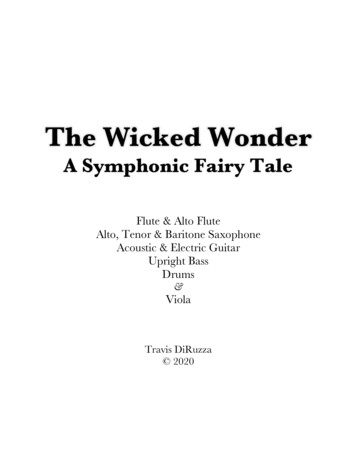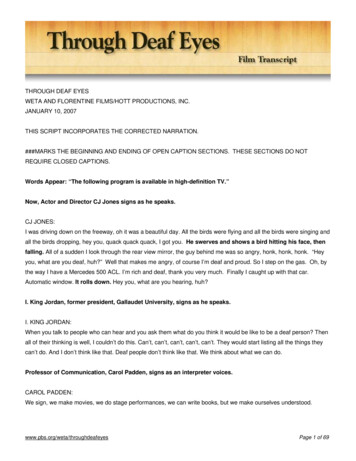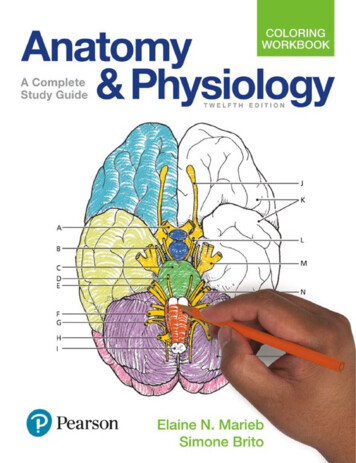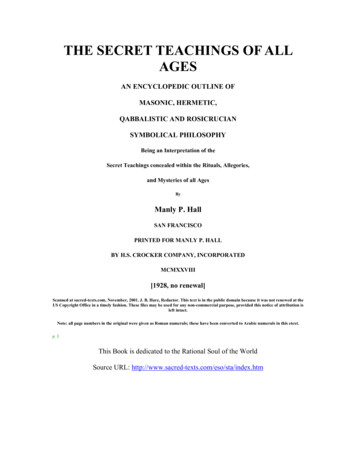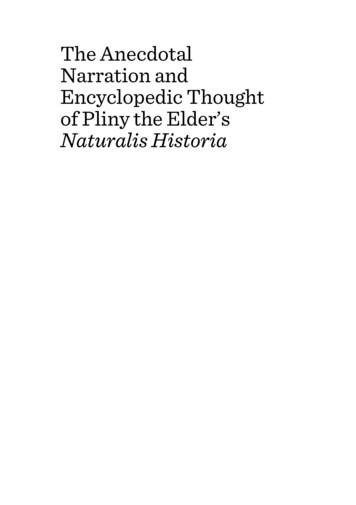
Transcription
The AnecdotalNarration andEncyclopedic Thoughtof Pliny the Elder’sNaturalis Historia
The AnecdotalNarration andEncyclopedic Thoughtof Pliny the Elder’sNaturalis HistoriaByÁgnes Darab
The Anecdotal Narration and Encyclopedic Thought of Pliny the Elder’sNaturalis HistoriaBy Ágnes DarabThis book first published 2020Cambridge Scholars PublishingLady Stephenson Library, Newcastle upon Tyne, NE6 2PA, UKBritish Library Cataloguing in Publication DataA catalogue record for this book is available from the British LibraryCopyright 2020 by Ágnes DarabAll rights for this book reserved. No part of this book may be reproduced,stored in a retrieval system, or transmitted, in any form or by any means,electronic, mechanical, photocopying, recording or otherwise, withoutthe prior permission of the copyright owner.ISBN (10): 1-5275-4850-3ISBN (13): 978-1-5275-4850-3
TABLE OF CONTENTSPreface . viI. The Death of the Actor: Marcus Ofilius Hilarius (Plin. NH 7.184–185) . 1II. Diui Augusti aduersa (Plin. NH 7. 147–150) . 11III. When Elephants Weep (Plin. NH 8. 20–21) . 22IV. Leo generosus and the Zoology of Pliny the Elder. 37V. The Wondrous Life of the Natural World: The Matter of Dolphins(Plin. NH 9. 20–33) . 57VI. The Lack of Description: Ialysus (Plin. NH 35. 101–106) . 70VII. Natura, Ars, Historia: Anecdotic History of Art in Plinythe Elder’s Naturalis Historia. Part I . 79VIII. Natura, Ars, Historia: Anecdotic History of Art in Plinythe Elder’s Naturalis Historia. Part II . 99IX. Corinthium aes: The Origin and Metamorphosis of an Anecdote . 119X. Corinthium aes versus Electrum: The Anecdote as an Expressionof Roman Identity in Pliny the Elder’s Naturalis Historia . 131Works Cited . 141
PREFACEPliny the Elder’s Naturalis Historia, with its varied content, enablesand expects us to employ a complex interpretative technique. Pliny’slanguage is doubly difficult. On the one hand, its language is incrediblycondensed, sometimes even to the point of inscrutability. On the otherhand, it is not a literary text, but a scientific one. The text’s varied nature,its varietas, is due not only to the subject of the encyclopedia but also itsstructure and Pliny’s diction since he never limited himself to a solelyscientific, objective presentation of things. Besides giving a neutralaccount of facts, he often goes into moralizing digressions, and wefrequently encounter vehement exclamations that also have a moralpurpose, as well as fairytale-like and anecdotal narration. Another aspectof Pliny’s diction is that he often interrupts the discussions of topics withthese digressions and begins to address something that seemingly hasnothing to do with the subject or which is only loosely connected to it.This is a peculiarity of the narrative of Naturalis Historia which cannot befound to such a degree in any other piece of scientific prose written inLatin.My hypothesis was that these digressions that occur in different placesand in great number throughout the text of Naturalis Historia should notbe regarded as mistakes fragmenting the structure of the text, and thus asevidence for a mismatch between Pliny’s rhetoric and theme. This aspectof my research has grown out of a paragraph from the praefatio (praef.12), which is usually disregarded in criticism. This part clearly points outthat Pliny saw the limits conferred by the subject and genre of NaturalHistory. He was perfectly aware that the description of nature is a drytopic (sterilis materia) which gives no opportunity for digressions fromthe topic (excessus), rhetorical speeches (orationes), pleasant chatting orpresenting certain thoughts (sermones), nor the description of miraculousoccurrences (casus mirabiles) and adventurous events (eventus varii). Aswe know, all these aspects appear in the text. From this we must concludethat Pliny did not intend these digressions as departures from the subjectmatter. In his words, these should not be regarded as excessuses but form apart of the topic.Most of these digressions are, or seem like, anecdotes. We cannotregard the anecdotes and anecdotal digressions as inorganic parts of the
The Anecdotal Narration and Encyclopedic Thought of Pliny the Elder’sNaturalis Historiaviitext, whose function is only to illustrate, to ease the dryness of the topicand to make the text more colorful. We cannot be satisfied with merelycomparing these stories with different versions appearing in other texts.Noting different versions is necessary, but only with the purpose ofexplaining why Pliny chose that specific variant of the story. We onlyhave a chance to answer this question if—after comparing them with otherversions—we reinstate the anecdotes in their original context and also askwhat role the anecdotes have in the structure of the text. Furthermore, weshould evaluate the anecdotes’ textual genres in that specific context.Researching the etiological anecdotes, the anecdotes about the life ofanimals, those about famous persons from political or intellectual life, andthe anecdotes about the most important Greek painters and sculptorsrequires the application of different perspectives. If there are texts writtenwith literary claims that could only be understood within the culturalconstellation they were written in, then Natural History is one of them.The reception of this text is only possible if we find the contexts ofcontemporary cultural-medial relations, which enable such an understandingto take place.Pliny wanted to write a useful work (praef. 16: utilitatem iuvandi). Forthis purpose, he adjusted not only the content and the structure but also, Ibelieve, the textual genres of the encyclopedia as well. If we approach theanecdotal digressions of Naturalis Historia with the proper methods, wecan open up the cultural, ideological and moral implications of the work’sstructure and different textual genres. This approach is hard to apply for allthe thirty-seven volumes of the work. However, we can draw relevantconclusions about the whole text from the analysis of certain narrativeunits and thematic groups. The thematic and narratological examinationsof anecdotes yield such results that show that the anecdotes and anecdotaldigressions—contrary to the common critical view—were not placed inthe text due to a lack of narratorial self-control, to ease the dryness of thetopics or as entertaining pieces. When we approach anecdotes from theperspective of narrative techniques, the role of the stories as exemplabecomes clearer, and its further aspects can be spotted. This research alsodraws attention to Pliny the writer, an aspect of the text that has beencontested until very recently; from the end of the 19th century on, manycritics formulated a need to point out the literary qualities of the work, butthey failed to give a proper account of the theme.The ten chapters presented here focus on the anecdotic narration ofNaturalis Historia. These essays have been published in English, Germanand Hungarian, and were slightly reworked and bibliographically updatedfor this volume. The original places of publication are the following:
viiiPrefaceI. Darab, Ágnes. “The Death of the Actor: Marcus Ofilius Hilarius.Plin., Nat. VII 184–185.” Acta Classica Universitatis ScientiarumDebreceniensis 50 (2014): 139–147.II. Darab, Ágnes. “Adversa Divi Augusti. Pliny the Elder: NaturalisHistoria 7. 147–150.” Acta Antiqua Academiae Scientiarum Hungaricae55, no. 1–4 (2015): 273–281.III. Darab, Ágnes, “When Elephants Weep. Plin, Nat. VIII 20–21.”Acta Classica Universitatis Scientiarum Debreceniensis 51 (2015): 75–88.IV. Darab, Ágnes. “Res ardua vetustis novitaten dare. A leo generosusés idősebb Plinius zoológiája.” Antik Tanulmányok (Studia Antiqua) 59(2015): 213–229.V. Darab, Ágnes. “Az élővilág csodálatos élete: a delfin-matéria.” InMiraculum, A csodák szerepe és jelentősége az európai kultúrtörténetben,szerk. Tóth Orsolya, 113–131. Hereditas Graeco-Latinitatis VII. Debrecen:Klasszika-filológiai és Ókortörténeti Tanszék, 2018.VI. Darab, Ágnes. “Ialysus: the Lack of Description.” Acta ClassicaUniversitatis Scientiarum Debreceniensis 48 (2012): 75–89.VII. Darab, Ágnes. “Natura, Ars, Historia. Anecdotic History of Art inPliny the Elder’s Naturalis Historia. Part I: Natura and Ars: the Place ofArt History in the Naturalis Historia.” Hermes 142, no. 2 (2014): 206–224.VIII. Darab, Ágnes. “Natura, Ars, Historia. Anecdotic History of Art inPliny the Elder’s Naturalis Historia. Part II.” Hermes 142, no. 3 (2014):279–297.IX. Darab, Ágnes. “Corinthium Aes. Entstehung und Metamorphoseeiner Anekdote.” Wiener Studien 128 (2015): 69–82.X. Darab, Ágnes. “Corinthium Aes versus Electrum. The Anecdote asan Expression of Roman Identity in Pliny the Elder’s Naturalis Historia.”Hermes 140, no. 2 (2012): 149–159.I wish to express my gratitude to my translators, József SzabolcsFagyal (IV–V, IX) and Gyula Somogyi (preface, I–III, VI–VIII, X) as wellas to my proofreader, Maya Berger, whose professional work and helpfulefforts made this volume possible.
I.THE DEATH OF THE ACTOR:MARCUS OFILIUS HILARIUSPLIN. NH 7. 184–185The narrative of Pliny the Elder’s Naturalis Historia has receiveddiverse evaluations in the past century and especially in recent decades. Itsearliest assessment comes from Pliny the Younger, who characterized hisuncle’s encyclopedia with three epithets: Naturae historiarum trigintaseptem, opus diffusum, eruditum nec minus varium quam ipsa natura. 1 Hegives the meaning of varium himself: this opus—that is, the text itself, too,is as varied as its subject, nature. Eruditum obviously refers to thescholarly or scientific modality of Naturalis Historia. The most pertinentadjective is the third epithet, diffusum, which condenses differentmeanings: the text is lengthy, its theme is diverse and—even though Plinythe Younger might not have had this in mind—the narrative techniqueitself is diffuse as well. This is something more than varietas, whichcharacterized not only Naturalis Historia but became an ambitious literaryrole declared and put into practice by Roman compilators. 2If we consider the adjective diffuse only in a narrow sense, as a certaincharacteristic of the narrative, we find in it the most ‘Plinian’ trait of thetext: the narrative technique, the similar application of which cannot bePlin. Ep. 3. 5. 6.Trevor Murphy, Pliny the Elder’s Natural History: The Empire in theEncyclopedia (Oxford: Oxford University Press, 2004), 38–40; Thorsten Fögen,Wissen, Kommunikation und Selbstdarstellung. Zur Struktur und Charakteristikrömischer Fachtexte der frühen Kaiserzeit (München: C. H. Beck, 2009), 24–25.The variety in content, structure and narrative can be interpreted metaphorically aswell: this variety is like the most popular type of mass entertainment, thespectacles of circuses and amphitheaters. See Mario Vegetti, “Zoologia eantropologia in Plinio,” in Plinio il Vecchio sotto il profilo storico e letterario. Attidel convegnio di Como 5-6-7 ottobre 1979 (Como: 1982), 121–124.12
2I.found in any other examples of Latin scientific prose. 3 This specificity canbe found in the digressive nature of the storytelling, which leads Pliny todiverge from his subject to other, seemingly unrelated topics, events hehas seen, heard or read, and anecdotes or observations. Ever sinceNaturalis Historia lost its scientific value but its merits have been pointedout by literary criticism, this is the most important trait that fulfills acentral role in the evaluation of the encyclopedia. And the evaluationranges from labeling the book a compilation without concept and balance, 4to regarding the author as a person unable to resist the urge to “telleverything” and emphasizing his inability to create coherent texts, 5 toadjectives like “digressive”, 6 “associative” 7 and “anecdotic”. 8 Thequestion is not about how we characterize them but about their function:do these excursuses have any role, and if yes, what kind of role do theyplay in the text of the encyclopedia?The story of the title character of the essay can be read in book 7 ofNaturalis Historia, the so-called anthropological book, which reviews allknowledge about humankind. The story draws our attention not onlybecause of the information above, but also because it is the only text fromthe literature of the antiquity which tells us about the event of the death ofthe actor whose name we cannot find anywhere else but in theencyclopedia. Pliny relates the story in the following way:Operiosissima tamen securitas mortis in M. Ofilio Hilario ab antiquistraditur. Comoediarum histrio is, cum populo admodum placuisset natalisdie suo conuiuiumque haberet, edita cena calidam potionem in pultariopoposcit, simulque personam eius diei acceptam intuens coronam e capiteThorsten Fögen, “Pliny the Elder’s Animals: Some Remarks on the NarrativeStructure of Nat. Hist. 8–11,” Hermes 135, no. 2 (2007): 192–196.4 Martin Schanz–Carl Hosius, Geschichte der Römischen Literatur bis zumGesetzgebungswerk des Kaisers Justinian, vol. 2: Die Zeit der Monarchie bis aufHadrian (München: C. H. Beck, 1959), 775.5 Eduard Norden, Antike Kunstprosa (Leipzig: B. G. Teubner, 1923), 314; FrancisRichard David Goodyear, “Pliny the Elder,” in The Cambridge History ofClassical Literature, vol. II: Latin Literature, ed. E. J. Kenney, W. V. Clausen(Cambridge: Cambridge University Press, 1983), 174–175.6 Murphy, Pliny the Elder’s Natural History, 29–32.7 Fögen, “Pliny the Elder’s Animals,” 193.8 See in this volume “Natura, Ars, Historia: Anecdotic History of Art in Pliny theElder’s Naturalis Historia, Part II.”3
The Death of the Actor: Marcus Ofilius Hilarius Plin. NH 7. 184–1853suo in eam transtulit, tali habitu rigens nullo sentiente, donec adcubantiumproximus tepescere potionem admoneret. (NH 7. 184–185) 9A most artistically contrived tableau of serenity in death, involving M.Ofilius Hilarius, is recorded by the ancient sources. This comic actor, whohad always enjoyed popular success, held a banquet on his birthday. Whenthe meal had been served, he called for a hot drink and, gazing at the maskhe had been wearing that day, transferred to it the wreath on his head. Inthis attitude he grew stiff without anyone noticing, until the diner next tohim warned him that his drink was getting cold. 10Hilarius’s death is as scenical as his theatrical art. The phraseoperiosissima securitas introducing the anecdote condenses differentmeanings. The joyful banquet is organized by Hilarius, who, because ofhis art, is very good at throwing parties; even his name—which derivesfrom the adjective hilaris, “joyful”—predestines him to such a role. Thelaurel wreaths were not only worn at the conviviums; they also refer tofuneral feasts, which Romans attended with wreaths on their heads. Thefigure of the kline—the couches which Romans lay on during funeral aswell as other festival feasts—can also be interpreted as a similarly doubleallusion. Hilarius’s body lying on the kline evokes both situations: hisliving, then inert, body condenses the sight of the conviviums and theposture of the statues found on Etruscan-Roman sarcophaguses and urns,which represent the deceased. In this sense the joyful banquet becomes theprefiguration of a funeral feast, and the scenical gesture of the laurelwreath placed on the mask becomes Hilarius’s stylish farewell from hislife.The elaborate nature of the short story is shown not only by theconsistent duplication of the meanings and references but also by the punused in the narrative. The calidam—rigens—tepescere effectively sums upthe whole story: the drink is not even cold when Hilarius passes away.Even though the narrative is short, it has a big arch: it ranges from birth todeath. This is the only way the remark in the story—that the feast wasoccasioned not only because Hilarius had a spectacular success in thetheater but also because it was his birthday—can make sense.I quote the text of book 7 according to the Budé edition: Pline L’Ancien, HistoireNaturelle, Livre VII, texte établi, traduit et commenté par Robert Schilling (Paris:Les Belles Lettres), 2003.10 I quote the English translation of book 7 according to the newest edition: MaryBeagon, The Elder Pliny on the Human Animal: Natural History, Book 7 (Oxford:Clarendon Press, 2005).9
4I.Pliny’s narration obviously pays much attention to the presentation andthe wording of this uncommon event, with all its allusions and the vividspectacle it offers, even though this is an insignificant case given theserious subject of book 7 of the encyclopedia. In other words, the storyevidences the pictorial potential of language and its ability to visualizeevents, which in rhetoric we call enargeia, illustratio or evidentia. 11 Thisis precisely the contrast—between the insignificance of the actor and therhetorical polish of the narrative—that requires further explanation. Plinyhimself gives the most useful guideline in dealing with this situation, aswell as all the digressions and seemingly irrelevant remarks found inNaturalis Historia: nec quaerenda ratio in ulla parte naturae, seduoluntas. 12 Pliny gives the theoretical foundation of this method, as wellas his view of nature, in book 7. 7: Naturae uerum rerum uis atquemaiestas in omnibus momentis fide caret, si quis modo partes eius ac nontotam complectatur animo. 13 We can only understand the overarchingnarrative about nature and the excursuses if we examine and interpret it asa part of a narrative and ideological whole.The story is not only about the end of Hilarius’s life, but it concludesone of the distinct narrative units of Naturalis Historia: an enumeration ofsudden—and in Pliny’s regard, fortunate—deaths. This five-chapter-longtext (NH 7. 180–185) recites twenty-nine cases when life ends in aninstant, without any previous warning, and many of these stories belong tothe genre of mirabilia literature. A common motif between all these eventsis that the title characters are snatched away by death at the height of theircareers. The author’s enumeration ranges from Chilo of Sparta (NH 7.180), who was one of the Seven Wise Men, to Pliny’s own age (NH 7.184), culminating in Ofilius’s story (NH 7. 184–185). The death of theactor at the top of his career is at once the rhetorical climax of the seriesFor more on the meaning of the three expressions in rhetorical terminology, seeQuint. Inst. 6. 2. 29–32. For a more extensive treatment of the ekphrasis of poeticaltexts and rhetorical enargeia, see Gottfried Boehm, “Bildbeschreibung. Über dieGrenzen von Bild und Sprache,” in Beschreibungskunst—Kunstbeschreibung. DieEkphrasis von der Antike bis zur Gegenwart, eds. Gottfried Boehm and HelmutPfotenhauer (Frankfurt am Main: Wilhelm Fink, 1995), 23–40; Simon Goldhill,“What is Ekphrasis for?” Classical Philology 102, no. 1 (2007): 1–19; Ruth Webb,Ekphrasis, Imagination and Persuasion in Ancient Rhetorical Theory and Practice(Farnham: Ashgate, 2009), 13–39.12 Plin. NH 37. 60.13 Plin. NH 7. 7: “Indeed, the power and might of nature lacks credibility at everypoint unless we comprehend her as a whole rather than piecemeal.”11
The Death of the Actor: Marcus Ofilius Hilarius Plin. NH 7. 184–1855and it gives an effective contrast to the next, less fortunate deaths: suicidescommitted because of banal reasons. 14These chapters are part of a bigger narrative unit, the stories which—inone way or another—are all connected to the theme of death. The textualunit that comprises twenty-two chapters (NH 7. 168–190) poses thisquestion in connection with the notion of felicitas: it asks how longsomeone can live, then goes on to summarize the knowledge about oldage, terminal illnesses, death and afterlife. Pliny also gives a briefsummary of funeral customs, then—as a logical conclusion to the topic—goes on to ask whether death really is the end of life, or whether there issomething beyond, an afterlife. This bigger narrative unit seamlessly fitsinto the whole structure and argumentation of book 7, which is thefollowing:1. A moralizing introduction to man’s place in nature and therelationship between man and nature (1–5).2. Nations with special characteristics (6–32).3. Life from birth to death (33–190):a.) conception, pregnancy, birth, infancy, inheritance (33–77).b.) significant physical and intellectual capabilities (78–99).c.) significant virtues (100–122).d.) significant accomplishments in science and art (123–129).e.) felicitas and fortuna (130–152).f.) the unpredictability of fate and lifespan (153–167); death (168–190).4. A catalog of mankind’s most significant inventions (191–209).5. Consensus between the people of the world: writing, shaving andthe concept of time (210–215).The shift from extreme to everyday, from miracles to average events,from barbarity to civilization and culture, from periphery to center is oneof the structuring principles of book 7; the other principle that determinesthe order of the units is man’s life from birth to death. The chaptersranging from 33 to 190 follow, just like the whole book does, the mostbasic process in man’s life: they describe conception, birth, growing upand death (everyday events as well as incidents belonging to the categoryof mirabilia). And what is between growing up and dying: the fulfillmentof human life. This is what the exemplums are about, which all featuregreat Roman figures exemplifying rationality (ratio), morality (mos) and14NH.7. 186: Haec felicia exempla, at contra miseriarum innumera.
6I.virtues (virtus). The reader of book 7 must be surprised to see how Pliny,who adores the perfection of nature, introduces death with the followingsentence: “Natura uero nihil hominibus brevitate uitae praestitit melius.” 15Then he goes on to enumerate fortunate 16 and unfortunate 17 cases of death,and he calls sudden death summa uitae felicitas, 18 the biggest luck in life.He calls the teachings about the transmigration of souls, or life after death,madness and self-delusion. 19 He concludes—rhetorically as well—thisargumentation with which he started: sudden death being the biggest good,“praecipuum naturae bonum”. 20When dealing with the questions of death and the transmigration ofsouls, Pliny—whose thinking had primarily been influenced by stoicphilosophy—seemingly takes sides with the epicureans. However, we findthe closest parallel with his thinking in Seneca: Mors est non esse. Id qualesit iam scio: hoc erit post me quod ante me fuit. 21 Just like how Senecaequated death with the state preceding birth when no perception exists,Pliny states that Omnibus a supremo die eadem quae ante primum; necmagis a morte sensus ullus aut corpori aut animae quam ante natalem. 22Pliny’s statement could be interpreted from the perspective that heattributed divine power—without which immortality cannot be imagined—only to nature. 23 This interpretation would stand if Pliny devoted himselfconsistently to the stoic or any other philosophical schools. However,NH 7. 168: “The truth is that nature has given man no better gift than shortnessof life.”16 NH 7. 180–185.17 NH 7. 186.18 NH 7. 180: In primis autem miraculo sunt atque frequentes mortes repentinae —hoc est summa uitae felicitas — quas esse naturales docebimus. “Among themost marvelous and frequent occurrences, which I shall show are natural, aresudden death, life’s greatest happiness.”19 NH 7. 188–190.20 NH 7. 190: Perdit profecto ista dulcedo credulitasque praecipuum naturae bonum,mortem. “Such seductive delusions in reality destroy nature’s supreme gift,death.”21 Sen. Ep. 54. 4: “Death is non-existence, and I know already what that means.What was before me will happen again after me.” (Transl. by Richard M.Gummere).22 NH 7. 188: “After our last day, we are all in the same state as we were beforeour first; body and soul have no more sensation after death than they had beforebirth.”23 Mary Beagon, Roman Nature: The Thought of Pliny the Elder (Oxford:Clarendon Press, 1992), 92–102.15
The Death of the Actor: Marcus Ofilius Hilarius Plin. NH 7. 184–1857Pliny was no theoretician, he was practical minded in everything he did. 24So the answer should be sought not in philosophical principles but withinthe text of Naturalis Historia.If we take a look at the examples of sudden death, one common motifstands out: they are all about active and strong men who have just startedto attend some public duties, or they have just completed these duties.Death comes for them before old age or illness; they live Pliny’s own idealtype of life, which he summarizes in the praefatio as uita uigilia est. 25“Living means being awake,” that is, being active for the community, forthe state, just like the examples—including Pliny’s own 26—demonstrate.In contrast, unfortunate deaths are the pathetic results of suicide, divorceor even the sorrow felt over a favorite charioteer. If we evoke one of themost important themes of book 7, the Plinian evaluation of memoria, 27which is the most significant of mental capabilities, even the text’s rhetorichelps us find the solution. Death is the greatest good man can get fromnature: praecipuum naturae bonum, mortem. 28 Memory is the most neededgood in life: Memoria necessarium maxime uitae bonum. 29In this sense, life is only good while we retain our memory andintellectual capabilities, which enable us to act, to be useful persons, tofulfill the ideal of uita uigilia est. Thus the most needed and greatest goodis memoria, and the prime examples of its use are Kyros, L. Scipio,In Pliny’s thinking, there is no sharp boundary between official religion(religio), superstitions (superstitio) and natural philosophy (for example, theteaching about the principle of sympatheia–antipatheia behind all the events ofnature); see Thomas Köves-Zulauf, “Plinius der Ältere und die RömischeReligion,” in Aufstieg und Niedergang der Römischen Welt, vol. II. 16. 1, hrsg.Hildegard Temporini und Wolfgang Haase (Berlin, New York: De Gruyter, 1978),197–198.25 NH praef. 19.26 For a good summary of Pliny’s military and public roles, his activities as writerand his life in general, see John F. Healy, Pliny the Elder on Science andTechnology (Oxford: Oxford University Press, 2005), 1–35; for a shorter version,see Beagon, The Elder Pliny, 1–5.27 Pliny gives an important role to memory in every respect. For example, it is theirgood memories that elevate elephants and dogs above all other animals in thewilderness or in the household (NH 8. 1 and 146). He attributes portrait sculpture(NH 34.16) and painting (NH 35. 4. 9–10) the function of remembering andperpetuation of the ancestor’s memory.28 NH 7. 190.29 NH 7. 88: “Of good memory, the most indispensable of life’s advantages, it isdifficult to name an outstanding example.”24
8I.Mithridates, or Iulius Caesar—kings and leading statesmen. 30 If fate is sokind to us as to spare us from the period of old age that destroys body andsoul, and sudden death prevents such an inglorious conclusion of life, thenthis is summa felicitas, the greatest luck, or praecipuum bonum, thegreatest good, given by a life identified with nature. This must also be thereason why Pliny mocks the foolish belief in an afterlife: Quae, malum,ista dementia est iterari uitam morte? Quaeue genitis quies umquam, si insublimi sensus animae manet, inter inferos umbrae? 31Pliny concludes book 7 not with the thought of total annihilation butwith a catalog of mankind’s most significant inventions and inventors. 32He introduces this twenty-five-chapter-long passage with the claim thatthis is the proper place for this enumeration (consentaneum uidetur),before he leaves the theme of this book, the description of human nature(priusquam digrediamur a natura hominum). This is doubly true accordingto the logic of Naturalis Historia. On the one hand, it is connected to thearrangement of knowledge that we find in the encyclopedia. Pliny givesthe description of materials and creatures in a tripartite construction:locality / habitat, a short account of the phenomenon / the creature, and itsutility / usefulness. 33 If we project this systematic narrative structure ontobook 7, Pliny gives the habitat of different people, followed by adescription of the people and the physical, intellectual and ethical-moralaccounts of their most significant thinkers, concluding with the thirdnarrative unit: the introduction of mankind’s most important inventionsNH 7. 88–91.NH 7. 190: “Scoundrel! What is this mad idea that life is renewed in death?What peace will the generations ever find if consciousness is retained by theirsouls in the upper world and their shades in the underworld?”32 NH 7. 191–215. For the rhetorical strategy in Pliny’s heurematography and theinterpretation of it as a teleological narrative, see Marco Mistretta, “Empire andInvention: the Elder Pliny’s Heurematography (NH 7. 191–215),” Acta ClassicaUniversitatis Scientiarum Debreceniensis 54 (2018): 123–135.33 For a consistent use of the narrative construction giving the occurrence,description and utilization, see in this volume “Corinthium aes versus Electrum:The Anecdote as an Expression of Roman Identity in Pliny the Elder’s NaturalisHistoria.”For utilitas as a central theme in Naturalis Historia, see Sandra CitroniMarchetti, “Iuvare mortalem. L'ideale programmatico della Naturalis Historia diPlinio nei rapporti con il moralismo stoico–diatribico,” Atene e Roma 27 (1982):
When Elephants Weep (Plin. NH 8. 20–21) . 22 IV. Leo generosus and the Zoology of Plin

